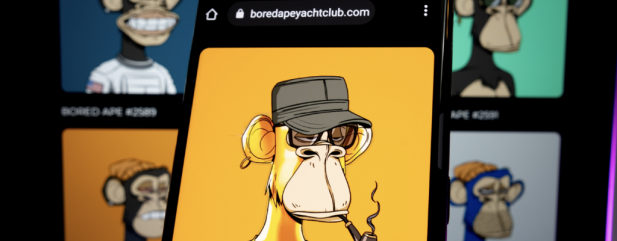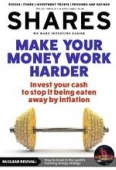Archived article
Please note that tax, investment, pension and ISA rules can change and the information and any views contained in this article may now be inaccurate.
NFTs are all the rage but should investors bother with them?

If you had to search the internet for ‘non-fungible token’ or ‘NFT’ on the day Rishi Sunak announced he was asking the Royal Mint to create one, you’re probably not alone.
While NFTs have a growing fanbase which resulted in $25 billion being spent on them by collectors and traders last year, according to DappRadar, they’ve not cut through to mainstream investing yet.
In a nutshell, NFTs are digital assets but the value comes from a unique proof of ownership stored on the same blockchain that’s used to buy and sell cryptocurrencies. Some of those assets also have a tangible twin – think of a work of art that can also be physically hung on a wall, but most NFTs are virtual only.
One of the most famous examples of an NFT features the first ‘tweet’ put out by Twitter creator Jack Dorsey which sold for $2.9 million and is now back on the market for over $48 million.
There is potentially money to be made but the value of NFTs is still largely untested and in the end it all comes down to how much someone else is willing to pay for what you have.
There is no history to look back on and no precedent to determine if your investment decision looks sound. Ultimately it all comes to down to taste and risk.
RANGE OF NFTS
Plenty of individuals and businesses scent an opportunity, from artists like Damien Hirst and pop stars like Justin Bieber to multi-national corporations and sporting conglomerates. This means NFTs have become prolific in a short space of time.
NFTs can be more than just an image, they can capture a moment in time, a phrase of music, a virtual frock or pair of shoes, a skin for your avatar or a GIF.
Prices vary widely, unsurprisingly the rarer the item the more people are willing to pay. Justin Bieber-backed ‘Bad Ted’, the colourful creation of InBetweeners artist Gianpiero D’Alessandro, has harnessed the pop star’s fan network to great effect and the average ‘bear’ is now selling on NFT marketplace OpenSea for an average of $3,000 though one has fetched over $120,000.
Clearly there is a risk the NFT you acquire might not appeal to anyone else in which case your investment might end up being rendered worthless.
BUSINESSES JUMP ON THE NFT BANDWAGON
Investors who aren’t sure about NFTs might find they have shares in one of the myriad companies already on the bandwagon.
Nike (NKE:NYSE) recently snapped up a company that designs virtual trainers; Coca-Cola (KO:NYSE), Gucci and Adidas (ADS:ETR) have also jumped in.
Paramount has come in for quite a bit of stick from Star Trek fans for its journey into the NFT frontier with algorithmically generated ‘star ships’ on sale for $250 dollars each. The idea is these ships will enable you to engage with the Star Trek universe, set out on ‘missions’ and experience, well… experiences. But that’s still some way off and currently they’re the equivalent of a fridge magnet but stuck on your virtual wallet rather than your kitchen’s cooler.
One of the most successful forays into NFTs has been from the world of sport. The NFL has taken a logical step from trading cards to trading tokens and it has also given value-added benefits to fans who attended this year’s Superbowl as they each received a complimentary NFT which commemorated their attendance – a sort of digital keepsake.
But a charity venture by Liverpool Football Club which looked to sell over 100,000 NFTs was something of a flop and drew criticism from fans that the club was trying to exploit them.
TIP OF THE ICEBERG
Tech companies from Meta Platforms (FB:NASDAQ) to Apple (AAPL:NASDAQ) are making moves and it’s easy to understand why.
My teenage children spend their lives in virtual worlds. They think nothing of spending all their pocket money on skins, avatars, outfits and weaponry needed to succeed in quests or blend in with teammates, though most of those transactions are not currently in the NFT sphere.
For them, the blending of their real and online lives is seamless, a concept Meta Platforms’ founder Mark Zuckerberg is hoping to push further.
Institutions like the Royal Mint getting involved might offer some kind of stability, adding an almost inherent value. And an offering from Damien Hirst came with a deal that after three years you could swap your NFT for the tangible piece and whichever one you didn’t choose would be destroyed.
Stunt or smart move, it does give NFT dabblers a modicum of control, much in the same way an NFT from the Royal Mint might confer a modicum of certainty. NFT investment funds are also being launched, another indication the financial sector is sitting up and taking notice.
RISKS TO CONSIDER
There are risks – not just those already discussed but also from an increasing amount of fraud.
The relative newness of the investment means many consumers have little knowledge of exactly what makes an NFT and so don’t take the basic steps to make sure the item they are buying is real.
Plus, the burgeoning popularity of NFTs has acted as a magnet for scammers who are clever at exploiting any perceived weakness in the system.
Then there’s the basics of making sure your ‘seed phrase’ – the password to your virtual wallet – is safe and secure. One misstep and you could find yourself counting the cost.
Regulators will catch up as this world progresses. Until then investors need to be on their guard, to be safe and not sorry.
Important information:
These articles are provided by Shares magazine which is published by AJ Bell Media, a part of AJ Bell. Shares is not written by AJ Bell.
Shares is provided for your general information and use and is not a personal recommendation to invest. It is not intended to be relied upon by you in making or not making any investment decisions. The investments referred to in these articles will not be suitable for all investors. If in doubt please seek appropriate independent financial advice.
Investors acting on the information in these articles do so at their own risk and AJ Bell Media and its staff do not accept liability for losses suffered by investors as a result of their investment decisions.
Issue contents
Feature
- Looking for an ESG investment? They tend to fall into six different baskets
- Is your favourite investment trust in safe hands?
- Stocks and funds which could power up on nuclear's glowing prospects
- Why there is more to come from AstraZeneca as its shares hit a new record high
- Make your money work harder: invest your cash to stop it being eaten away by inflation
- This is why shares in ITV have been a bad investment for years

 magazine
magazine










